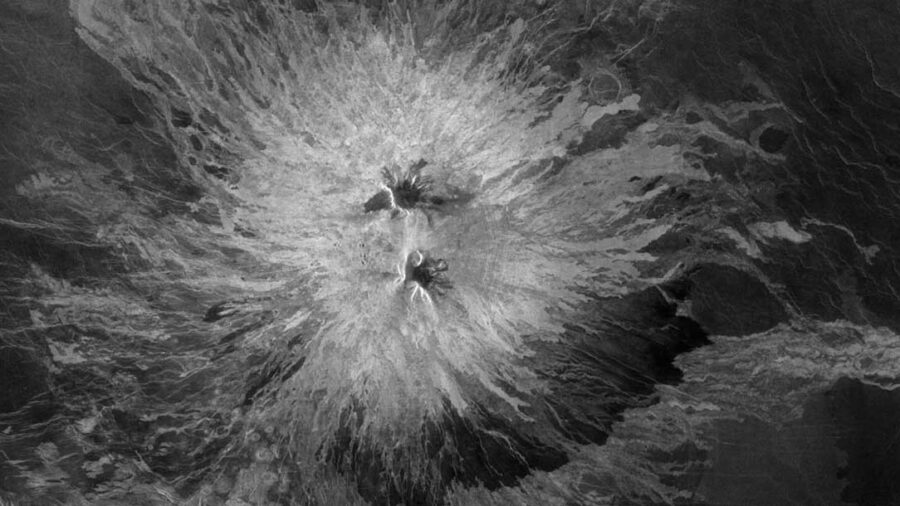Don’t disbelieve the hype: New evidence for active volcanic vents on our sister planet is convincing.

NASA / JPL
“Finally! Scientists Find Active Volcano on Venus.” Okay, S&T headline writer, you’ve got my attention (see page 8). When I first saw headlines making this claim, I was excited but wary: Scientists analyzing orbital radar images from our sister planet have actually discovered a volcanic vent that clearly changed size and shape? I had to read the peer-reviewed paper, but . . . wow!
There’s a special thrill in finding something moving and changing on the surface of another planet. We’ve photographed plenty of ancient, cratered surfaces on the Moon, Mercury, Mars, and many asteroids and moons. Yet some of the most memorable planetary images capture those rare times when we catch something in the act: a volcano erupting off the edge of Io; a recent landslide or dust-devil track on Mars; the flash of an impact on the Moon.
One place we’ve long hoped to see some surface change or motion is Venus, our nearest planetary neighbor and in some important respects Earth’s closest twin. Our planet’s continuous surface churning is driven by heat from its hot, partially molten interior. We expect Venus, nearly the same size and density, to have similar heat flow, so it should be active.
For decades we’ve gathered circumstantial evidence for active volcanism there. We’ve observed the amount of sulfur dioxide (a volcanic gas) fluctuating in the high atmosphere, as if fed from unseen eruptions. The Magellan mission, “seeing” the surface through the clouds with radar, mapped wide-ranging volcanic landforms. Some looked quite young. But are they? In the early 2000s, Venus Express showed that some of the freshest-looking volcanoes have infrared signatures consistent with the rocks being younger than the surrounding plains. Recent lava flows?
My favorite hint is one you can see with your own eyes. Venus is so bright because of those highly reflective sulfuric-acid clouds. But chemical reactions with surface minerals would remove all that sulfur in about 10 million years — unless something is feeding sulfuric gases into the atmosphere, maintaining the cloud decks.
In 2014, news outlets also declared active volcanoes on Venus. They reported on a series of bright spots in the infrared, as seen in archived Venus Express data. One could interpret those spots as heat from lava flows.
Given all this, when I first saw those recent headlines about newly discovered volcanic activity, I was prepared for another “Well, maybe” response. Mind you, I’m pretty sure there are active volcanoes. But I don’t want this particular result to turn into another “NASA Discovers Water on Mars . . . Again” situation. So before I read the scientific paper (see https://is.gd/Venusactive), I thought “This had better be good.”
It is good. A round volcanic vent about a mile across on the side of a large volcano, observed again eight months later, is noticeably larger and elongated. Something has obviously changed in the before-and-after images (see the pair on page 8). There has been flow or collapse. This volcano is not extinct. Color me convinced.
We can explain away all the other evidence for volcanism, but here a picture is worth a thousand words, or megabytes of data. Of course, there’s so much more to learn — we don’t know how common such changes are or how the level of activity compares to Earth’s — and we need to stay tuned for the multiple Venus missions planned for early next decade (S&T: May 2022, p. 12). But seeing is believing. Venus has a beating heart.
This article originally appeared in print in the July 2023 issue of Sky & Telescope. Subscribe to Sky & Telescope.
 0
0









Comments
You must be logged in to post a comment.